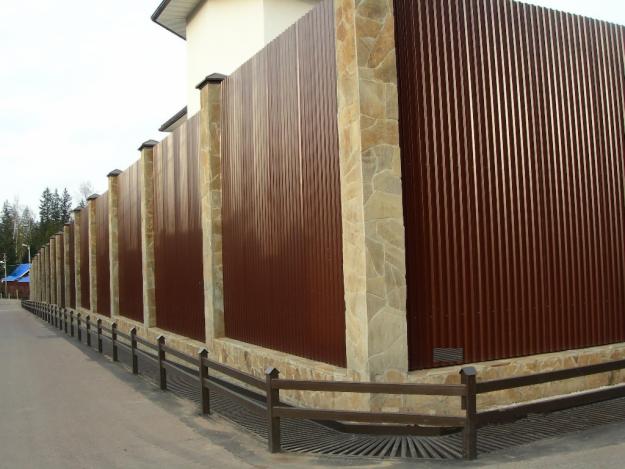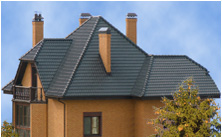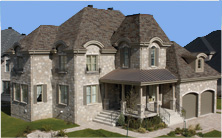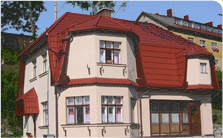Building fences to testify. Types of fences
Building fences to testify. Types of fences

Fences - our national heritage, character traits and ways of thinking. Since the days of princely feuds one way or another we have fenced it all: from the land and the city park to the backyard lawn and the last refuge. We love itself off, to show independence, to create his own world and no one there will not be tolerated. The words "city", "City", "fence" - same root. Folk wisdom says: "The higher the fence - the better relations with your neighbor." So today, with the development of private housing, behind the tall walls can hide not only the leaders.
Fences and all other protections are many different functions. They mark the boundaries, conceal property from the looks of bystanders. Protect the land, house and its owners from intruders or animals, as a necessary complement to protection or guard dog. Even a small fence is a psychological and a physical barrier to the attacker and makes his way back with the booty. As an integral part of landscape design, fences divide the garden into functional areas, to protect it from wind, provide support for climbing plants, give the site a special color, showing taste and prosperity of the owner, his claim to themselves and others. They can sometimes prevent an accident: a small child run out into the street, and inconsiderate guests will not fall into a decorative pond.
In principle, the fence can be made out of everything. A well-deserved popular wood, brick, concrete and wire mesh. Can not but welcome the emerging recently differentiated approach to the fence when the area fenced combined: from the possible threat - a high brick wall, with the front side - lacy wrought-iron railings on low stone foundations, and from neighbors - a grid or a light fence. This is consistent with statutory law that deaf and can only be a high fence with the front side and from the driveways and along the border with the neighboring areas are permitted only "transparent" fence of netting or fence height not exceeding 1.8 m in order not to obscure neighbor or your own landing.
Often erect fences are not from one but from several building materials (wood, stone, wood and brick, brick and cast-iron, wood and concrete blocks, etc.). From durable materials perform supporting columns and cap, which put up wood paneling, or iron grilles.
Like a stone wall
The main advantage of fences made of stone or brick in the fact that they are the most reliable and unapproachable, and give them the necessary ease by using arches and niches for the vases. Thanks to the decorative, they blend into the landscape of the site. Stone fences are durable, like any other, usually brick fence costs more than 50 years. The proximity of the road or nisin shorten its life, but be that as it may, brickwork - for decades. She is good and what does not require any maintenance: no need to paint or grease, nor clean.
For sampling using either ordinary red or face brick. Common brick is too rough, it has to be plastered. As a natural stone masonry using cobblestone, limestone, coquina and sandstone.
Monotonous brickwork makes sense to diversify the posts that have and will give the construction of additional strength. The optimal length of span between the posts depends on the height and wall thickness: from 2,5 m (if in a half-brick masonry and not more than two meters) up to 4-5 meters. Pillars bury in the ground to the level of freezing. To ensure the safety pillar reinforce - set the rod that is outside obkladyvayut brick. Rod can serve as a metal pipe with a diameter of 100-150 mm or more reinforcing rods.
And a wall of natural stone, and brick or concrete block fence with hedges need thorough strip foundations. You can save a little, if as a basis for laying between the pillars lay the channel.
The defense of concrete
The easiest and most reliable way of capital fencing device - to set the standard reinforced concrete slabs. They are more durable and stronger than a brick wall, with 10-15% cheaper. On durability of concrete fence is second only to the fence of stone, which is very expensive. Plasticity of concrete can be obtained from him almost any shape. Fence panels - the tech capital of the fence, installed easily and quickly, like a child's constructor, you need only tap the appropriate duty. However, there is a lack of concrete, which until recently limited its application - a dull gray color, solid blank plate. Not even rescued a huge selection on the market facade paints for exterior use on concrete, if desired concrete fence can be painted like wood, adding any color.
Breakthrough was the development of technology of decorative concrete - now out of it manufactured plates in color and texture indistinguishable from natural stone, wood, old brick. Like other concrete structures, the concrete <fake> not subject to the whims of weather, and strength are not inferior masonry. Installation of high-tech boards. A finished fence looks very solid and decorative, especially if the supporting columns made of brick. If desired, you can order one-sided plates (from the outside - the picture from inside - flat wall), or bilateral.
Iron curtain
Niche of middle-class domestic zaborostroenii occupy metal fences that are constructed of mesh-netting from welded gratings or grids of artistic casting or forging. Lattice can be any height, but should not be discordant with pillars and landscape the site. The combination of forged trellises and pillars and walls of natural stone in harmony and unusually decorative.
Metal fences are good for areas with large, dense plantings of trees and shrubs that protect owners from prying eyes. In terms of landscape design this type of fence - the most convenient, since <is dissolved> in the environment and requires no decoration. Merits of such barriers are many: they are durable and resistant to mechanical damage, they need only minimal care, which consists in the periodic painting, metal fences always look neat and stylish. Section gratings are manufactured at the factory and assembled on site on the metal or stone pillars, or bolt, or by welding.
Street in the box
A fence made of metal mesh - the most simple, affordable and versatile. Sale many kinds of grids - different width and length, with large and small cells, black, galvanized or vinyl-coated.
The most practical stainless steel wire mesh with galvanized zinc coating: it does not need painting every year, it does not lose its decorative (colored vinyl flooring with time fade in the sun, can be cracked by changes in temperature, especially in winter). But non-galvanized wire-netting, especially with the fine mesh of 10-15 mm, in any case can not be used for a fence - it does not protect against corrosion, no paint, and already three years later she prorzhaveet through.
To tension the mesh set poles stand-up, at intervals of not more than three meters. Most often used for this purpose asbestos or metal pipes and steel bath. Of course, the metal pole prorzhaveet necessarily, but as soon as a grid, which according to the most conservative estimates, will serve at least twenty years. Depending on the soil may have to fill posts in concrete. Corner posts enhance braces, as they have the maximum load. Likewise stake for gates and doors.
If you installed the fence seemed to you too <clear>, you can cover the rack with decorative plates or boards, and on the lower and upper edges of the grid to put wooden slats or boards with a thread. Such a fence would look more thorough and much more aesthetic, especially in summer, when each section is possible to plant a few climbing flowering plants.
Wooden fences
They can be called classic: from ancient times in Russia were built around cities, farms and fields, wooden fences of logs, boards or rods. A lot of options so far. In the west, a wooden fence - a symbol of wealth and prestige. We can it be a work of art, and dull fence. If the owners money is tight, then they usually put the wooden fence of the most primitive kind and extremely short-lived (5-10 years). About the price, even can not speak - such fences if not free, then purchased for a very nominal amount.
In general appearance and design can be identified:
fence - fence slats nailed to the horizontal crossbar;
fence - a fence of woven saplings and sprouts of bushes;
palisade - a series of stakes driven into the ground close to each other;
wooden fence - a fence with openings of boards nailed to the vertical supporting columns, or a horizontal crossbar. Boards nailed lap. This rugged and reliable fence, but it's not too beautiful, especially from the bars;
fence of wooden panels.
If you value your work and you have this opportunity, before assembling all the wooden parts of the fence, be sure to handle the antiseptic composition. Upper edge of boards or pickets should be slanted to the rain and snow did not stop at the ends of boards, do not penetrate the wood and did not provoke rot. It is desirable to sharpen and the upper edge of the traverses. For painting of wooden fences are suitable for almost any paint outdoors.
The advantage of the wooden fence is to protect from the wind. Solid capital fence causing a sharp rise in air flow and an equally sharp drop him on the other side of the fence, creating a devastating downdrafts. Mesh metal fences do not protect from the wind at all.
A thin, semipermeable wooden fence reduces the wind velocity, dissipates its energy. Windproof height of the fence depends on the size of the site and is the latest as of 1:10. For example, the fence height of 1.5 m to protect the lee of the land up to 15 m.
Hedges
You can, of course, to sit behind a stone wall and watch the world through the eye of the camcorder. And you can feel the unity with nature and breathe in through the open window scent of fragrant blooming peace. Sophisticated hedge not only stunningly beautiful, but also serves as an excellent guard territory. Lush vegetation can be more formidable obstacle than an ordinary wooden fence.
"Green" and the fence will provide protection from prying eyes, will help protect land from wind. Not in vain across the agricultural fields specially planted windbreaks of trees.
If you want to draw the outer boundaries of the site is likely to require plants rather tall shrubs, usually the height of a fence is maintained at two to three meters. Desired shape can be achieved regular hairstyle. For the green wall is ideal willow, viburnum suit, Derain, hazel, honeysuckle, common and Tatarian honeysuckle, some chubushnika, golden currant, and others. For high barbed fences are good and barberry hawthorn ordinary. Totally deaf fence can be obtained from planting willow or hawthorn, if with increasing twist their branches.





